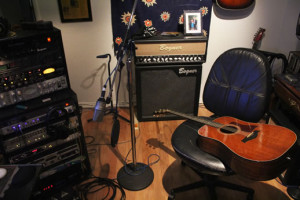Going into the studio used to be an exciting experience as a musician. I remember when we went into Sunset Studios in Hollywood and recorded songs we practiced as a band. I was in awe of the equipment as well as the process. It took half a day to set up the drums and get everybody miked up. Then we would record several takes in the hope to capture a magic performance. The changes in the music business brought with them the loss of many affordable studios. Now I record mostly in my own home studio and usually I am by myself or with one other musician when I record.
 Everybody seems to have a home recording studio setup these days. Equipment is relatively cheap. ( I might refer you to my 2011 post about prioritizing what to get in home recording studio equipment) You most likely have a computer anyways, so just add some software and get some acoustic treatment for your bedroom or garage. And for the outboard gear, even if you buy a couple good tube mic preamps, two decent microphones and Analog to Digital converter, you’ll find it hard to spend more than 15 grand. While that is not necessarily cheap for a lot of folks, the similar setup would have costed upward of half a million just 20 years ago. I admit I simplified the comparison a bit, but my point stands, it just costs a fraction of the cost to obtain decent recording equipment.
Everybody seems to have a home recording studio setup these days. Equipment is relatively cheap. ( I might refer you to my 2011 post about prioritizing what to get in home recording studio equipment) You most likely have a computer anyways, so just add some software and get some acoustic treatment for your bedroom or garage. And for the outboard gear, even if you buy a couple good tube mic preamps, two decent microphones and Analog to Digital converter, you’ll find it hard to spend more than 15 grand. While that is not necessarily cheap for a lot of folks, the similar setup would have costed upward of half a million just 20 years ago. I admit I simplified the comparison a bit, but my point stands, it just costs a fraction of the cost to obtain decent recording equipment.
But that doesn’t mean we are getting the same results. Here is what I consider to be the main differences:
The first there is the acoustic space. A proper recording studio is always going to sound better than your bedroom or garage. This can be counteracted somewhat by proper acoustic treatment, adding bass traps and acoustic reflectors to the walls etc. Then close miking an instrument, so you don’t get much of the room sound, and applying of a good reverb plug-in can produce good results.
Secondly, not everybody is an engineer. Many musicians have a hard times switching from the creative right brain mode to the more analytical left brain. when trouble shooting a signal flow in the recording chain. You can say you’ll loose the vibe when you have to figure out why the guitar sounds distorted due to a bad patch cable. I feel fortunate to have had the experience to work in a proper studio as an engineer. So I am quite comfortable with equipment. However, I always prefer to have a setup day, where I get the amps and microphones placed, dial in the right tone, set the right recording level and balance the headphone mix. When I come in the next day, I just start recording and that frees up my head to concentrate on my performance.
But what we are mostly missing is the live interaction of musicians who play together in the same room. This, by necessity, has been replaced by carefully overdubbing individual parts one by one. And there it gets tricky. I heard too many recordings that sound clean but sterile, just for that reason. As a music producer I pride myself to being able to create tracks that have that live feel even when parts are overdubbed one by one. Just to share a few tricks:
A) hire the right musicians. There is no substitute for a great player, But be aware, that the best player you now might not be the best player for a particular track. Getting the right musicians is the key.
B) I often record parts more than once, especially my parts. I may lay down a guitar track to programmed drums, then record live drums and bass. I find what magic happens between drums and bass and redo my guitar part to emphasize it, just as if I was reacting to it when we play live. Then when I add keys, I listen to the voicings used and I might re-adjust my rhythm guitar parts to complement the keyboard parts. I might go back to edit some bass or drum notes in order to catch some accent I played on the lead guitar track. So I move back and forth until I arrive at a recording where each part is reacting to the other’s performance. It’s more work, but until I get a recording budget, that allows me to hire the players I want, rehearse and go into some of the big studios left in town to record my albums, that technique works quite well.
If you want to check out Nils’ productions, you can listen to samples of his music on his album page and on this page of featured artists he produced.
2 Comments
Trackbacks and Pingbacks
Trackback URL for this post:
https://www.nilsguitar.com/working-in-a-home-recording-studio/trackback/
-
… [Trackback]
[…] Read More: nilsguitar.com/working-in-a-home-recording-studio/ […]
-
… [Trackback]
[…] Read More Infos here: nilsguitar.com/working-in-a-home-recording-studio […]
